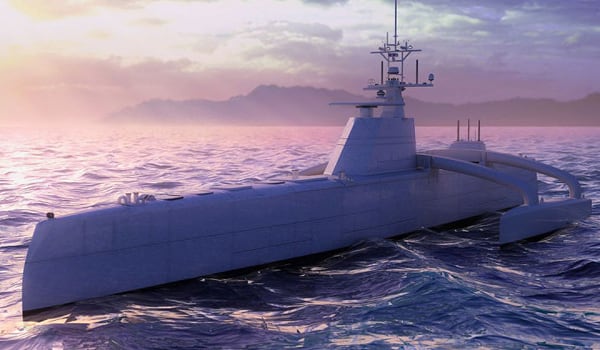WASHINGTON — The head of the U.S. Navy’s Fleet Forces Command has ordered the service’s surface force to develop a concept of operations for both the large and medium unmanned surface vessels in development, according to a Dec. 19 message seen by Defense News.
The message, which was coordinated with U.S. Naval Forces Europe and U.S. Pacific Fleet, directs the surface fleet’s Surface Development Squadron to develop concepts for “the organization, manning, training, equipping, sustaining, and the introduction and operational integration of the Medium Unmanned Surface Vehicle and Large Unmanned Surface Vessel with individual afloat units as well as with Carrier Strike Groups, Expeditionary Strike Groups, and Surface Action Groups.”
The message comes after a long battle with Congress over funding for unmanned surface combatants, during which lawmakers expressed skepticism that the Navy was knowledgeable enough about the technology for which it was seeking funding. Ultimately Congress appropriated funds for the Navy to buy two large unmanned surface vessels, but lawmakers forbade the service from equipping the vessels with vertical launch tubes, as the Navy intended.
The concepts of operations is meant to define what would be considered “initial operating capability” for the medium and large USVs and goes on to define what those platforms are intended to do.
“Medium Unmanned Surface Vehicle will be a high-endurance vessel with capacity for carrying various modular payloads,” the message read. “Large Unmanned Surface Vessel will be high-endurance vessel equipped with Vertical Launch System (VLS) cells.
“The Medium Unmanned Surface Vehicle will initially focus on intelligence, surveillance and reconnaissance (ISR) payloads and electronic warfare (EW) systems, while the Large Unmanned Surface Vessel will focus on surface warfare (SUW) and strike missions.”
The message directs the Surface Development Squadron, which was created last year to incorporate new technologies such as the DDG-1000 and Sea Hunter into the force, to examine several areas of consideration.
The group is to examine command and control for the platforms, as well as potential challenges with interoperability and communications; examine issues with basing, maintaining and supporting the new platforms; look at what the vessels will need in terms of sensors, computers and various supporting systems; and look at what kind of training and personnel will be needed to support unmanned operations.
The group is directed to have a first draft by February and a final draft prepared by September of this year. Ultimately the group’s work is intended to help inform acquisition requirements.
RELATED

Strings attached
The Navy recently emerged from a bruising fight with Congress over its designs for integrating unmanned technology into the surface force.
Navy leaders have publicly acknowledged congressional skepticism. In October, the Navy’s top requirements officer told an audience at the Expeditionary Warfare Conference in Annapolis, Maryland, that the platform will be difficult to develop.
“I don’t want to be Pollyannaish about this: It’s going to be hard work,” said Vice Adm. Jim Kilby, the deputy chief of naval operations for war-fighting requirements and capabilities. “And when we brief this, we go right to the upper right-hand corner of the difficulty spectrum.
“So we have been working with the acquisition community to roll out a test and competence program so we can get something to the war fighter that they’re confident they can use.”
What Congress wants to see is more gradual development and proof of concept before it commits serious funding, Kilby told reporters after his remarks. "What I think they are interested in is ‘Block I will have the following capabilities and we’re going to test them in the following manner, and you can see the results of that test,’ ” Kilby said. “Then we are going to move on to Block II and Block III. They’re interested in us having a ramp-up and build confidence, achieve those capabilities and they can follow that.
“Let’s talk about that first instantiation: Maybe that’s going from point A to point B, follow [the International Regulations for Preventing Collisions at Sea], not hit anything, follow the rules of the road. Well, that serves a number of purposes from a deception standpoint. And if those platforms can do that, then maybe I can add capability as I prove out that concept.”
The message from Fleet Forces Command described the Navy’s acquisition strategy as “a rapid, iterative, block approach to further develop, test, and employ new capabilities, aligned with the Surface Capability Evolution Plan,” referencing a document developed inside the office of the chief of naval operations that lays out plans for a future surface force.
Congress approved the two LUSVs the Navy requested, but forbade the service from installing a vertical launching system. Furthermore, lawmakers are withholding funding until the Navy’s top acquisitions official briefs them on the path forward for these systems.
“Incremental upgrade capability for a vertical launch system may be addressed in future fiscal years,” read the agreement between House and Senate appropriators. “It is directed that no funds may be awarded for the conceptual design of future LUSVs until the Assistant Secretary of the Navy (Research, Development and Acquisition) briefs the congressional defense committees on the updated acquisition strategy for unmanned surface vessels.”
David B. Larter was the naval warfare reporter for Defense News.






